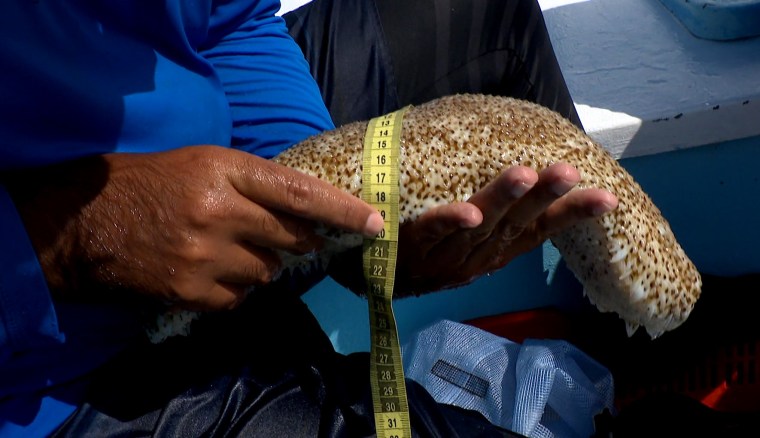[ad_1]
PROGRESO, Mexico — Ricardo Domínguez Cano stared at the Yucatán Peninsula’s intense blue sea as he remembered a different time, before a vital sea animal was endangered.
“The sea cucumber was not something special, until the prices began to rise a lot,” Cano, 47, told Noticias Telemundo. “Many people then came from other [Mexican] states and settled in Yucatán for the cucumber. And they continued fishing, despite the ban.”
“The sea cucumber could be finished,” the third-generation fisherman said sadly.
Local fishermen, conservationists and scientists and scholars are sounding the alarm on the dwindling numbers of these marine animals known for “cleaning the bottom of the sea,” according to Cuauhtémoc Ruiz Pineda, a researcher at the National Fisheries Institute (Inapesca), which is in charge of monitoring these animals.
But there’s a demand for them, especially in Asia. Due to intense overfishing, sea cucumber populations declined so much in Yucatán that Mexico banned fishing for them in 2013.
The numbers of sea cucumbers have not yet recovered enough to allow a resumption of fishing activities, but it’s still being done: According to the Food and Agriculture Organization of the United Nations (FAO), almost 1,600 tons of sea cucumber were fished in Mexico in 2020.
According to data from the Mexican Government, 100% of sea cucumbers are exported, mainly to the Asian market — Hong Kong and other Chinese cities — and secondly to the U.S.
The Center for Biological Diversity has denounced that the importation of sea cucumber to the U.S. has increased by 36 times in the last decade, and has requested that it be protected under the Endangered Species Act.
The FAO estimated that more than 215,000 tons of sea cucumbers were caught from 2013 to 2017 globally. Of that figure, around 7,800 tons were caught in Mexico.
As with other endangered species, such as the totoaba in Mexico, the main reason for the indiscriminate fishing of cucumbers is economic. Larger and better processed specimens fetch high prices on the Asian market: A kilo can cost $600 to $3,500 or more in Hong Kong and other Chinese cities.

Across the world, an appetite for it
Sea cucumbers are invertebrate animals that live in rocks, seagrasses or algae in the sea bed. Soft and slimy to the touch, they perform an important environmental role — eating all of the organic detritus that is in the sand and leaves it clean, allowing various species to coexist and recycling, remineralizing and oxygenating the seabed.
“Without the sea cucumber, the ocean floor is changed,” Ruiz Pineda said.
In the sea cucumber trade, the main product is its dried body wall, which is reconstituted with a slow-cooked boil and consumed in sauces or soups. In traditional Asian medicine, it’s believed that it helps treat the symptoms of diseases such as arthritis and that it has aphrodisiac properties.
In Mexico, “Chinese businessmen came who encouraged local fishermen to extract it when they saw the great value it has,” said Alicia Virginia Poot Salazar, a biologist and representative of Inapesca in Yucatan.
The cartels also fish
In March, an investigation found that from 2011 to 2021, Mexican and U.S. authorities seized more than 100.6 metric tons of sea cucumbers, with an estimated value of $29.5 million.
“Illegal fishing undermines conservation efforts, destroys wildlife populations and ecosystems, harms legal fishermen, steals dollars from governments, undermines good governance and social order, and fuels organized crime,” Teale N. Phelps Bondaroff, lead author of the research, said in a recent interview.
The document details a series of illegal practices that encourage the trafficking of the species, such as false identification, incorrect labeling, forged declarations, manipulation of invoices and fraud as a means of laundering illegal catches.
Although the Mexican government has implemented various measures such as seasonal restrictions, quotas, closed seasons and monitoring, the investigation found that authorities cannot control the intense trafficking of the species and documents the corruption schemes of local authorities and the use of clandestine facilities to process cucumbers.
Academics like Vanda Felbab-Brown of the Brookings Institution have investigated how organized crime groups have infiltrated Mexico’s fisheries.
“I would say that one of the most important findings of my investigation is that it’s not only about the presence of narcos from the Sinaloa Cartel and the Jalisco New Generation Cartel in illegal fishing, but also that they seek to take over the legal business and all the stages of production and marketing to establish a monopoly,” Felbab-Brown said.
In her research entitled “China-Linked Wildlife Poaching and Trafficking in Mexico,” she wrote that due to the decline in the species’ populations, poaching only produces a small crop that organized crime groups buy from local fishermen to sell to Chinese middlemen.
Low penalties for smuggling?
U.S. authorities frequently detain people associated with the smuggling of sea cucumbers, as was the case of Claudia Castillo, a Mexican citizen who was sentenced to eight months in prison and ordered to pay $12,000 in restitution to the Mexican government for the smuggling of sea cucumbers from Mexico to San Ysidro, California, in 2018 and 2019.
It also highlights the case of César Daleo, a former Border Patrol agent, who received simultaneous sentences of 30 and 24 months, respectively, for his role in sea cucumber and fentanyl smuggling operations.
Daleo worked as a border agent for 11 years and is believed to have been the leader of a larger network, which was being investigated and monitored by authorities. From 2014 to 2016, and on at least 80 occasions, Daleo paid someone else to smuggle bags of dried sea cucumber from Mexico to the United States. It is estimated that the shipments were valued at $250,000.
On March 8, 2018, David Mayorquin and Ramon Torres Mayorquin, owners of a company called Blessings Inc., pleaded guilty to 26 counts of illegally importing more than 128 tons of sea cucumbers from Mexico with an estimated value of $17.5 million dollars in the markets of Southeast Asia.
However, the Mayorquins received no jail time, and only had to pay $973,490 in fines, $237,879 in forfeited property, and $40,000 in restitution to the Mexican government.
Research by Bondaroff states that a common feature in all of these incidents is “the discrepancy between the value of the contraband goods and the fines and restitution imposed.”
As with many wildlife crimes, the fines and penalties are less than the value of the cargo seized, and are low compared to the penalties imposed on the smuggling of other illicit goods.
Risking lives for fishing
In order for sea cucumber fishing to be reactivated on the Yucatán coast, there must be at least 70 specimens per hectare — about two and a half acres. But despite the ban, that number has not yet been reached.
Intense overexploitation has also reduced the ability of the species to reproduce, which has led academic researchers to study how to repopulate them.
“With the fishing boom, the breeding banks where all the breeders were accumulated were decimated, the reproductive capacity of the species was reduced and it is currently very difficult to find good specimens,” said Miguel Ángel Olvera Novoa, scientific manager of the marine station of the Center for Research and Advanced Studies in Yucatan.
Olvera Novoa and his team took 14 years to achieve assisted reproduction of this species. However, much remains to be investigated.
“Our main objective is to try to produce juveniles to restore populations and try to recover species that were subjected to irrational exploitation,” the scientist said.
Another consequence of excessive fishing is that fishermen must dive to great depths in less explored areas to find the remaining sea cucumbers.
Many of these fishermen are at risk of decompression sickness because they are not well prepared to go so deep and don’t have the necessary equipment to adjust their bodies to the pressure changes experienced when climbing the surface.
“Cucumber began to be scarce and people began to get hurt. Some fainted, others came with injuries, their knees were damaged. Some were even disabled. In a season of 15 to 20 days there was a daily death, it was very ugly,” said David Domínguez Cano, a diver and the brother of Ricardo Domínguez Cano. In recent years, however, these kinds of deaths have declined.
For families like the Domínguez Cano, the sea is their livelihood and their home as they hope to preserve its sea animals and environment.
“We live from this and we are not going to deplete it,” he said, speaking of the area’s ecology and marine life as he gazed out at the water. “But the people who only come to make money are not interested in keeping it. We have to take care of everything, that is our main problem.”
Follow NBC Latino on Facebook, Twitter and Instagram.
[ad_2]
Source link

/cloudfront-us-east-2.images.arcpublishing.com/reuters/M4O2GCFNPNJNRAFOME2WYD3OAA.jpg)












